Perpignan is an important French city located 10 kilometers from the Mediterranean coast in the Languedoc region and north of the border with Spain.
Salvador Dali once said that Perpignan is the center of the world. And although his phrase is exaggerated, but in fact it is an interesting, lively, modern city, with roots dating back to the early Middle Ages. The medieval city center of Perpignan has a distinctly Catalan design.
Attractions Perpignan
The medieval city center is charming. Rivers run through its center, and beautifully planted gardens along their edges will not leave anyone indifferent. South of the river, walking along the narrow streets, you can enjoy the city center. Perpignan is ideal for tourists looking for a typical, laid back French town. Here you can spend time calmly, look into several shops, drink local wine, relax and chat with the local population.
The medieval center is quite small and can easily be walked around in half a day. On the edge of the old center is the Palace of the Kings of Mallorca, a very beautiful Moorish-style building. The part of the city leading up to the Palace of the Kings of Mallorca, which goes back to the 14th century, is the most interesting place for visitors, where there are several beautiful medieval buildings located around this section.
On the banks of the river Bass is a city castle called Castiller. Built in the 14th century, it was once used as a prison. It is currently known as the Museum of the History of Catalonia. Perpignan has its own local monastery of Saint-Jean. It was built in the 14th century in the Gothic style and became a cathedral after 1601. The cathedral was built under the influence of the Catalan style, especially its flamboyant bell tower. The cathedral itself has a very warm and friendly atmosphere inside.

Near the cathedral is Campo Santo - an unusual monastery-cemetery, the only one of its kind in France. Since it has a large outdoor center, it is often used for concerts in the summer. Opposite the cathedral you can see beautiful squares surrounded by multi-storey brick houses with light painted shutters and patterned balconies.
The highlight of the city is its beautiful Palace of the Kings of Mallorca. It was built in the 13th century for the court of Jacques II and is a mixture of civil and military architecture. It is built of beautiful red brick, and from its walls you will have an excellent view of the city and its surroundings. In the 17th century, Vauban, a famous French military architect, renovated the defenses of the palace. He built defensive walls around Perpignan, but these were removed as the city grew.
Other attractions in Perpignan

When you leave the palace and head west, you will find yourself in a less touristy part of the old city, which is populated mainly by Arab and gypsy families. This is the place where you will find decent North African coffee, delicious kebabs, and inexpensive tasty baklava. There are also markets where you can buy any spices or herbs and taste deliciously prepared cheap snacks from local bistros.
In Perpignan there is a decent art gallery - the Museum of Fine Arts of Hyacinthe Rigaud. Its collection includes works of art by Maillol, Picasso, Miro, Dufy. It is housed in an 18th century mansion. Another interesting building is Casa Hano. This is a 16th century mansion and the last remaining Gothic house in Perpignan. Its façade is decorated with a frieze showing the seven deadly sins.
Perpignan is a good place to enjoy picturesque villages, mountain scenery and historical monuments not far from the Western Pyrenees. The closest beach to Perpignan is in the eastern part of the city. Many of the beaches stretch along the coast and are a bit featureless and little visited.
Food and drink in Perpignan

The best of two European cuisines comes together in Perpignan, making it a place where you can't find bad food. Locally known ingredients such as figs and olives are added to Catalan and traditional French cuisine. Most meals will be accompanied by Catalan tomatoes, which are finely chopped and spread over butter on fresh bread. Thanks to Perpignan's proximity to the coast, seafood is common on the local menu, as are ducks and other, more unusual, poultry meats.
The region also boasts an assortment of local Languedoc wines, which come from plantations near Perpignan. In addition, it is known for its Catalan beer, which you can find in local bars. You will find Baniel and other sweet wines that will help you spend a colorful evening with a delicious dinner.
Thanks to its compact layout, ease of navigation and romantic, twisting streets, walking is an excellent mode of transport in Perpignan. You can get taxis, but they are not cheap. During your holiday in Perpignan, you will experience a variety of delights from a French city that offers a fascinating history, a mixture of cultures and delicious food with a Catalan twist.
